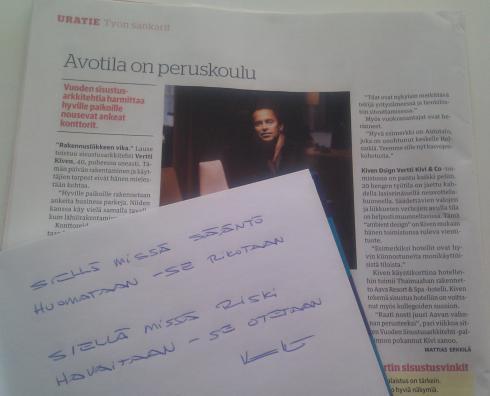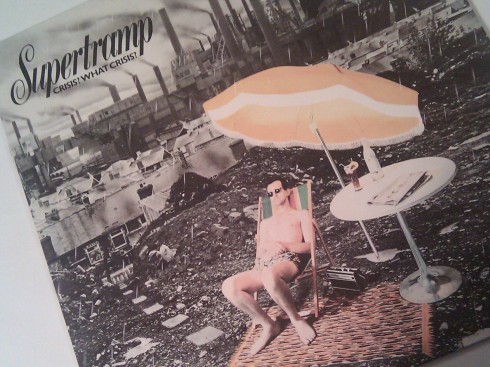
Vertti Kiven motto muistikirjani sivulla @ Pafos 2010
Yrittäjä ja sisutusarkkitehti Vertti Kivi pokkasi tammikuussa Vuoden Sisustusarkkitehti 2011 -palkinnon. Minulla oli ilo viettää kokonainen viikko Vertin seurassa Esa Saarisen Pafos-seminaarissa. Vertti jakoi viikon aikana monia hyviä ajatuksia ja pyysin häntä kirjoittamaan seminaarivihkooni yhden niistä, hän kirjoitti siihen seuraavat mielenpainuvat sanat:
Siellä missä sääntö huomataan – se rikotaan
Siellä missä riski havaitaan – se otetaan
Tämä ajatukset liikkeelle laittava lausepari on Vertin suunnittelutoimiston motto. Uuden suunnittelussa tarvitaan näkemystä, mutta myös uskallusta ja innostusta. En ihmettele, että mies palkittiin – mainiota ajatuksia päänsä pullollaan. Vertti on harmissaan siitä, että liian moni toimisto muistuttaa peruskoulun ruokalaa, eli ”linoa lattiaan ja loisteputket kattoon”, kuten hän Talouselämän (3/2011) jutussa lausuu. ”Epämiellyttävään tilaan meneminen vaikuttaa ajatuksiin uskomattoman paljon. Tila virittää ihmiset”. En voisi olla enempää samaa mieltä!
En kuitenkaan kirjoita nyt sisustamisesta (enpä siitä juuri mitään tiedäkään), vaan jäin miettimään Vertin mottoa ja suunnitteluideologiaa. En voi olla vertaamatta sitä startup-yrittäjän toimintaan: Säännöt ja riskit, miten ne kohtaa ja miten niihin asennoituu.
On paljon asioita, joissa sääntöjä tarvitaan. Mutta on myös sääntöjä, jotka aivan suotta rajoittavat ajatteluamme. Nämä, usein kirjoittamattomat, säännöt ohjaavat toimintaamme. Esimerkkinä vaikkapa TEKESin, rahoittajien ja muiden yrittäjille osviittaa antavien hyvät, keskinkertaiset tai huonot neuvot sekä ’Näin-meillä-on-aina-tehty’ -koulukunnan jumiutunut gramofoni. Jälkimmäisen edustajia löytyy sekä yrittäjäpiireistä, mediasta että viranomaisista.
Olen innokkaasti tutkinut yrittäjien menestystarinoita (sain hiljattain luettua opukset Rework ja Behind the Cloud). Niitä lukiessa pidin mielessä, että osa menestystarinoista on syntynyt erilaisessa markkinatilanteessa, ja siksi eivät ole suoraan sovellettavissa. Samasta syystä olemme turhaan toistelleet mantraa “uusinokia”. Silti olen saanut kirjoista monia ajatuksia pohdittavaksi ja yrittäjäkollegoiden kanssa jaettavaksi. Selkeitä, useampia toimijoita yhdistäviä sääntöjä on vaikea löytää.
Yksi selkeä “sääntö” tai pikemminkin ominaisuus löytyy kuitenkin lähes aina: korkea riskinottokyky, uskallus sekä palava innostus ja intohimo omaa ideaa kohtaan. Kuvaavaa on määrätietoinen eteneminen visiota kohti, sinnikkyys ja vahva tahtotila. Usein halutaan muuttaa maailmaa.
Intohimoa löytyy kotimaastakin: haluan mainita esimerkkinä ystäväni Janne Ruohiston, jonka yritys haluaa muuttaa tapaa, jolla osaamista haetaan, jaetaan ja löydetään yli organisaatiorajojen. Ja tietty oma yritykseni: haluamme muuttaa tapaa, jolla yritysten välillä sovitaan. Ei ihan helppoja nakkeja kohderyhmissä, joilla on pitkät traditiot, paljon sääntöjä ja joissa muutos on iso peikko.
Startup-yrittäjyys on sellaisenaan jo melkoista riskinottoa verrattuna kuukausiliksalla pakertavaan yrityksen työntekijään, virkamiehestä puhumattakaan. Uskon kuitenkin, että työn – ja erityisesti tietotyön saralla – käynnissä oleva voimakas muutos tekee tulevaisuudessa kaikista työntekijöistä yrittäjiä. Eli yrityksen sisälläkin on jatkossa jokaisen toimittava yrittäjän lailla. Olen miettinyt tätä aihetta paljon ja bloggaan tästä lähiaikoina.
Ei ole uutinen, että riskit kuuluvat yritystoimintaan. Käynnissä oleva yritysympäristön muutos tuo kuitenkin aivan uudenlaisia tilanteita ja niihin liittyviä riskejä. Sopivasti riskejä ottamalla jokaisella startup-yrittäjäkollegallani on mahdollisuus löytää jotakin, johon muut eivät ole huomanneet tarttua ja luoda uutta. Lisäboostia tähän tulee uudenlaisesta yrittäjäyhteistyöstä sosiaalisen median mahdollistama.
Toisinaan tulee stipluja, mutta useimmiten niistä selvää ehjin nahoin, ja voi jatkaa uutta oppineena – ja ennen kaikkea jostakin poisoppineena!
Taidanpa laittaa Vertin moton itselleni johonkin sopivaan paikkaan näkyville, muistuttamaan ja innostamaan.
PS. Omistan tämän kirjoituksen syntymäpäiväsankarille, rakkaalle ystäväyrittäjälle Eero Leppäselle!




